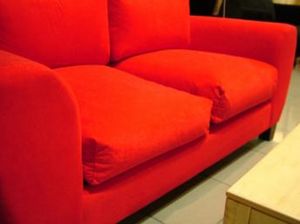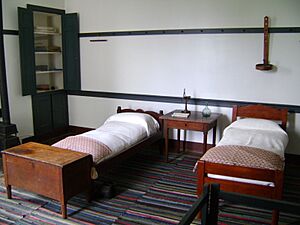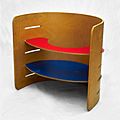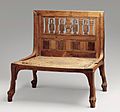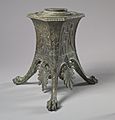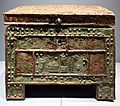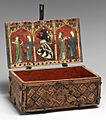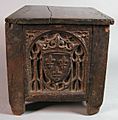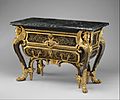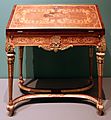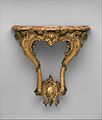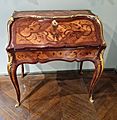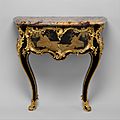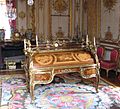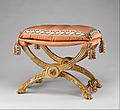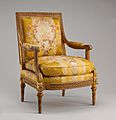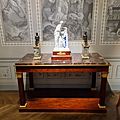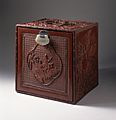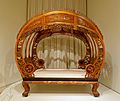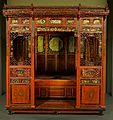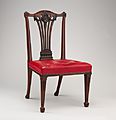Furniture facts for kids
Furniture means all the useful things in our homes and other buildings. Think of chairs, tables, beds, and cupboards – these are all types of furniture! People use furniture to sit, sleep, or store their belongings like clothes and dishes.
Furniture can be made from many different materials. Common materials include wood, metal, plastic, and even fabric. It often uses parts like screws and nails to hold it all together.
Different rooms have different kinds of furniture. For example, an office has desks and office chairs. A dining room has a table and chairs for eating meals. Classrooms and theaters have rows of seats for many people.
In a bedroom, you'll find a bed where you sleep. It usually has sheets, a bedspread, blankets, and pillows. Next to the bed, there might be a small table called a nightstand. You might put a lamp or a book there. A dresser is another common piece of bedroom furniture. It has drawers to keep your clothes tidy. Sometimes, a mirror sits on top of the dresser.
Contents
What is Furniture Made Of?
Furniture is built using many different materials. The choice of material depends on what the furniture is for. It also depends on how it should look and how strong it needs to be.
Common Materials for Furniture
- Wood: This is a very popular material. It's strong and can be carved into many shapes. Wood furniture can last a long time.
- Metal: Metals like steel or aluminum are used for strong, modern furniture. They are often found in outdoor furniture or office chairs.
- Plastic: Plastic is lightweight and can be made in many colors. It's often used for outdoor chairs or children's furniture.
- Fabric: Sofas and armchairs are covered with soft fabrics. These can be cotton, linen, or synthetic materials.
- Leather: Leather is a durable and stylish material. It's often used for sofas and chairs.
- Glass: Glass is sometimes used for tabletops or shelves. It gives furniture a light and open look.
Different Types of Furniture
Furniture helps us do many things in our daily lives. Each type has a special job.
Furniture for Sitting and Resting
- Chairs: These are for sitting. They come in many styles, like dining chairs, office chairs, and armchairs.
- Sofas and Couches: These are long seats for more than one person. They are usually found in living rooms.
- Beds: Beds are made for sleeping. They come in different sizes, like twin, full, queen, and king.
- Benches: A long seat, often without a backrest. Benches can be found indoors or outdoors.
Furniture for Storing Things
- Tables: Tables have a flat top and legs. We use them for eating, working, or holding items.
- Cupboards and Cabinets: These have doors and shelves. They are used to store dishes, food, or other household items.
- Dressers and Chests of Drawers: These have drawers for storing clothes.
- Bookcases and Shelves: These are used to hold books, decorations, or other small items.
- Wardrobes: A large cabinet for hanging clothes.
Furniture in Different Rooms
Every room in a house or building has furniture that fits its purpose.
Living Room Furniture
The living room is a place to relax and spend time with family and friends.
- Sofas and armchairs are central to a living room.
- Coffee tables are placed in front of sofas.
- TV stands hold televisions and media devices.
- Bookcases or display cabinets might hold books and decorative items.
Dining Room Furniture
The dining room is where people eat meals together.
- A large dining table is the main piece of furniture.
- Dining chairs surround the table.
- Sideboards or buffets might be used to store dishes or serve food.
Bedroom Furniture
Bedrooms are for sleeping and getting ready.
- The bed is the most important piece.
- Nightstands are next to the bed.
- Dressers or wardrobes store clothes.
- Sometimes, a small desk and chair are in a bedroom for studying.
Office Furniture
Offices are places for work or study.
- Desks are essential for writing or using a computer.
- Office chairs are designed to be comfortable for long periods of sitting.
- Filing cabinets help organize documents.
Related pages
Images for kids
See also
 In Spanish: Mobiliario para niños
In Spanish: Mobiliario para niños


